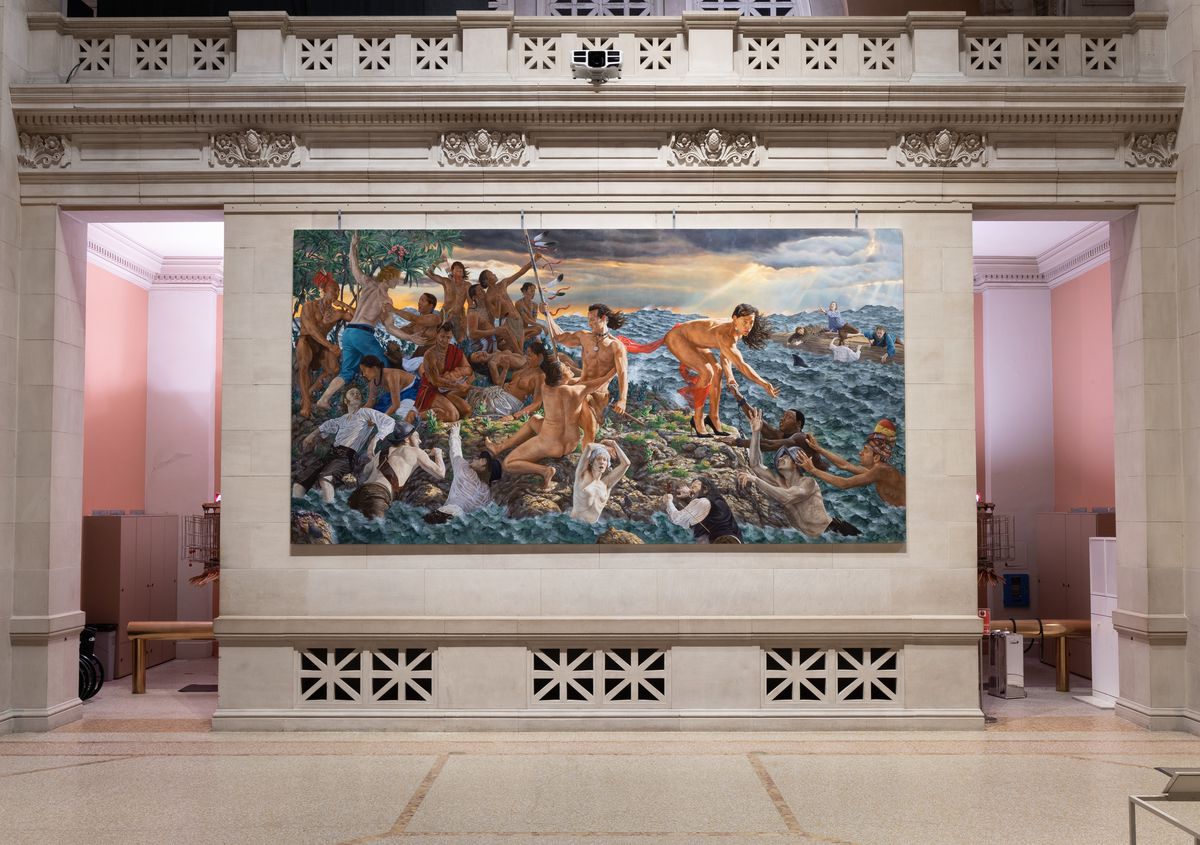Art
At the Met, Cree artist Kent Monkman asks visitors to confront North America's murderous past – The Globe and Mail

The Newcomers, 2019, for The Great Hall Commission: Kent Monkman, mistikosiwak (Wooden Boat People), 2019.
Courtesy of the artis/Anna-Marie Kellen/Metropolitan Museum of Art/Metropolitan Museum of Art
The Cree artist Kent Monkman stood under the soaring ceiling of the Metropolitan Museum of Art’s Great Hall this week wielding a laser pointer. With its beam, he indicated historical characters on the huge canvas behind him, stopping briefly on the figure of a beaver with an olive branch in its mouth as he decoded his latest painting for the assembled media. Europeans came to this continent seeking beaver pelts, he reminded them.
Toronto-resident Monkman, a member of Manitoba’s Fisher River Band, is one of a trio of international artists given an unusual assignment by America’s pre-eminent museum: The Met has asked them to address its encyclopedic collection by creating new art for its most prominent spaces. So, in the museum’s vast but always bustling front hall, Monkman takes the bull by the horns with a pair of canvases that cleverly appropriate Western history painting to expose romantic myths about Indigenous people. He is asking the Met and its many visitors to confront North America’s murderous colonial history – as Canada tries exporting Indigenous perspectives and the hope of reconciliation to the United States.
Borrowing the heroic poses and dramatic expressions from history paintings in the Met’s collection, Monkman calls his project mistikosiwak (Wooden Boat People), extending the Cree word for the French to include, by implication, all European settlers. The work is a diptych, depicting the arrival of Europeans in North America on the left and the resilience of contemporary Indigenous culture on the right. The first painting features a group of shipwrecked Europeans clambering onto a rocky shore where Indigenous characters variously welcome or repulse them. The second shows a boat paddled by contemporary Indigenous figures while two African-Americans pull white people from the water as though rescuing migrants from the Mediterranean. On a rock in the distance, armed men flash the white-power symbol and wave their guns.
Kent Monkman, (Canadian, b. 1965). Resurgence of the People, 2019.
Joseph Hartman/Metropolitan Museum of Art/Metropolitan Museum of Art
These paintings, created by a team of 10 painters under Monkman’s direction and based on photo shoots that employed about 40 models and actors, represent the artist’s increasingly sophisticated deployment of a revisionist history painting. As he resurrects the genre once considered the pinnacle of Western art before it was displaced by modernism, he exposes 19th-century history painting’s assumptions about North America as an empty continent ready for exploitation and Indigenous people as a noble but tragically disappearing breed.
”Here is this incredible vocabulary that I felt could be very relevant to speak about Indigenous experience both historical and contemporary,” he said in an interview at the Met this week. “It has been a way for me to engage with a very complex and sophisticated language of image-making and it ties into those themes of erasure that were present in the 19th-century [art]. Those themes have been supported and upheld by museums because they canonized that work.”
But no longer. As Monkman unveiled his paintings in a symbolically charged place – the entry point to the Met’s sprawling, global collection at the heart of a city that is a magnet for both tourists and migrants – Met leaders talked about the need to expand the stories the museum tells.
“Museums can no longer maintain a position of neutrality,” said Sheena Wagstaff, head of the Met’s modern and contemporary art department, as she launched into a rare land acknowledgement: Manhattan is Manahatta and traditional territory of the Lenape or Delaware nation.
As Cree artist Kent Monkman unveiled his paintings in a symbolically charged place, Met leaders talked about the need to expand the stories the museum tells.
Anna-Marie Kellen/Metropolitan Museum of Art/Metropolitan Museum of Art
As part of the current contemporary project, the Met has also mounted four striking female bronze figures by the Kenyan-born artist Wangechi Mutu in niches on the façade of its 1902 Beaux Arts building, the first time art has ever been placed there. The third participant in this program is the Icelandic multidisciplinary artist Ragnar Kjartansson, who mounted an immersive video installation in the courtyard of the museum’s Robert Lehman wing last summer.
Both of Monkman’s paintings in the Great Hall include something of a self-portrait: The central figure of Miss Chief Eagle Testickle, the artist’s gender-fluid trickster alter ego (whose memoir he is currently writing.) In the first painting, she is the one figure who looks directly at you as Monkman turns the tables on viewers of Western art, subjecting them to the Indigenous gaze. In the second painting, she stands at the prow of the boat, her pose directly borrowed from that of George Washington in the Met’s most popular American painting: Emanuel Leutze’s Washington Crossing the Delaware.
Monkman continuously adapts and undercuts these historical antecedents. He takes Eugène Delacroix’s The Natchez, in which the French artist depicted a Natchez couple and their new-born baby as the last of their kind, and purges the painting of its melancholic irony. Monkman’s first painting shows the couple joyfully welcoming new life; in the second, the parents are two women. Similarly, the figure of Mexican Girl Dying, a 19th-century sculpture by the American artist Thomas Crawford, has become a woman who appears to be in the throes of orgasm rather than death. Meanwhile, a group of Indigenous children in the boat was inspired by the biblical subject The Massacre of the Innocents, but their cropped hair is a reference to the residential schools where they were forced to assimilate.
More than three metres high and almost seven metres wide, the paintings are not Monkman’s largest; that honour still belongs to Miss Chief’s Wet Dream in the collection of the Nova Scotia Art Gallery. But they do represent his most sophisticated work yet. Where once the politics of his interventions might seem obvious – for Canada 150, he simply inserted Miss Chief into a familiar painting of the Fathers of Confederation – here his mastery of the Met’s collection lifts his art. The result is a complex iconography stuffed with references to historic art, Indigenous culture and contemporary politics as Monkman beats Western history painting at its own game.
Initiated by Met curator Randall Griffey, mistikosiwak has developed into a stealthy Canadian attempt to insert Indigenous perspectives deeper into the American cultural consciousness, long dominated by the troubled legacy of slavery.
“In Canada, museums are further ahead in engaging with Indigenous perspectives,” Monkman said. “There’s a huge difference: They are about a generation behind here. It’s a big moment for the Met to offer diversified perspectives.”
That was part of what attracted contributions from Canadian philanthropists Rosamond Ivey, and Marilyn and Charles Baillie, all of whom were already supporters of the Met and helped finance this project.
“It was a huge opportunity for Kent’s career and recognition for Canada’s artistic community,” Ivey said. “And the message is not really Canadian, it’s North American.”
The first of the millions who will see the paintings over the next four months got a look Tuesday as the media took their leave and the Met’s massive front doors opened to the public. The paintings hang immediately overhead at the coat-check queues, so visitors have plenty of time to consider them. Some began debating their merits and pointing out figures to each other from below. Others gazed up in silence, seemingly amazed.
mistikosiwak (Wooden Boat People) is on show at The Metropolitan Museum in New York until April 9.
Live your best. We have a daily Life & Arts newsletter, providing you with our latest stories on health, travel, food and culture. Sign up today.
How Kent Monkman works
In 2017, reporter Dakshana Bascaramurty and photojournalist Melissa Tait got an inside look at the process behind Kent Monkman’s work. Watch their video documentary, or click below to read the story.
From the archives: Kent Monkman, the modern touch of a master
Art
Duct-taped banana artwork auctioned for $6.2m in New York – BBC.com
[unable to retrieve full-text content]
- Duct-taped banana artwork auctioned for $6.2m in New York BBC.com
- A duct-taped banana sells for $6.2 million at an art auction NPR
- Is this banana duct-taped to a wall really worth $6.2 million US? Somebody thought so CBC.ca
Art
40 Random Bits of Trivia About Artists and the Artsy Art That They Articulate – Cracked.com
[unable to retrieve full-text content]
40 Random Bits of Trivia About Artists and the Artsy Art That They Articulate Cracked.com

Source link
Art
John Little, whose paintings showed the raw side of Montreal, dies at 96 – CBC.ca
[unable to retrieve full-text content]
John Little, whose paintings showed the raw side of Montreal, dies at 96 CBC.ca

Source link
-

 News17 hours ago
News17 hours agoEstate sale Emily Carr painting bought for US$50 nets C$290,000 at Toronto auction
-

 News17 hours ago
News17 hours agoCanada’s Hadwin enters RSM Classic to try new swing before end of PGA Tour season
-

 News18 hours ago
News18 hours agoAll premiers aligned on push for Canada to have bilateral trade deal with U.S.: Ford
-

 News17 hours ago
News17 hours agoClass action lawsuit on AI-related discrimination reaches final settlement
-

 News17 hours ago
News17 hours agoTrump nominates former congressman Pete Hoekstra as ambassador to Canada
-

 News17 hours ago
News17 hours agoFormer PM Stephen Harper appointed to oversee Alberta’s $160B AIMCo fund manager
-

 News17 hours ago
News17 hours agoEx-student pleads guilty to fatally shooting 3 University of Virginia football players in 2022
-

 News17 hours ago
News17 hours agoComcast to spin off cable networks that were once the entertainment giant’s star performers





















